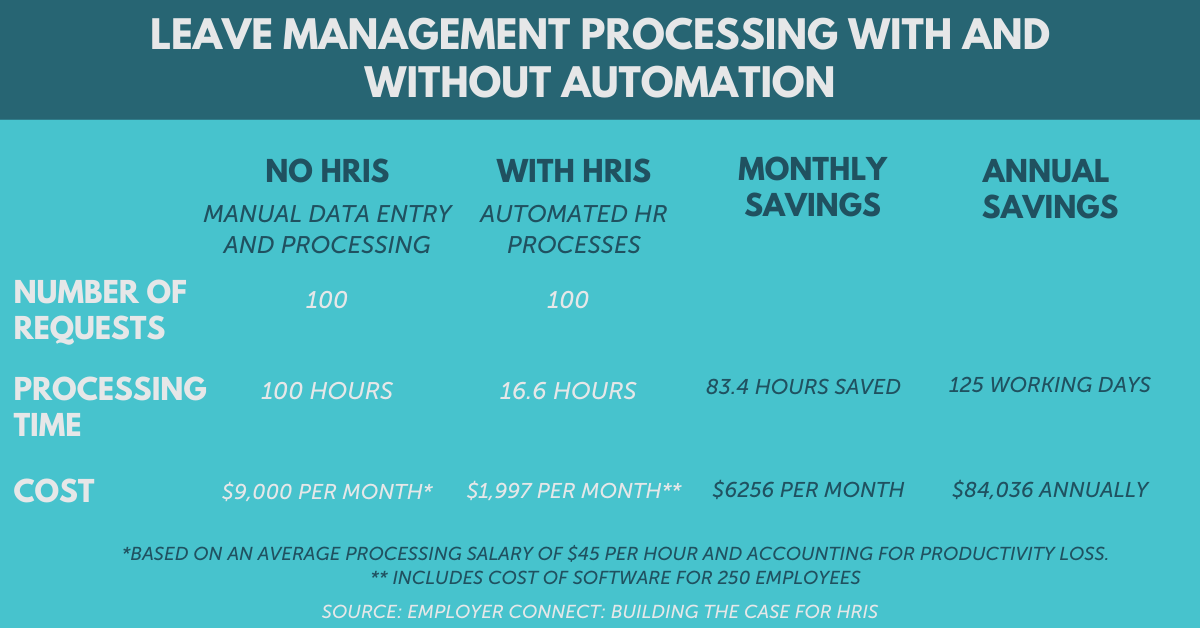
4 Steps to Consider When Implementing an HR Solution
Successfully implemented HR software saves businesses valuable time and money. An IBM survey found that total HR cost per employee decreased by 22% after two years. However, even though HRIS platforms are a critical business tool, implementing them can sometimes seem overwhelming.
In this article, we’ll discuss what an HR system implementation is and the role it plays in the success of your organization. We’ll also talk about four steps to consider when implementing an HR solution, so you get the best return on your investment.
What is Human Resource Implementation? Why is it Important?
Human resource implementation is the process of transitioning from one HR platform to another. A fully utilized HRIS management system is important because it can alleviate common issues for HR professionals.
For example, businesses with fully implemented HRIS systems save $84,036 annually by automating leave management processes. These systems achieve measurable results by providing HR managers with tools like online employee record-keeping and a centralized database of information.

A few other benefits of an HR system implementation include:
- Accurate employee information
- Decreased errors associated with data entry
- Increased position retention
- Mitigation of payroll tax compliance risks
- Understanding the importance of HR system implementation can help you when it comes time to transition your company.
1. Create An HR Implementation Plan
How an HRIS implementation process is handled sets the tone for your future relationship with your provider. You want to ensure you’re working with a reliable provider who will support your business strategy.
Work with your vendor to create an HR implementation plan, so you know what to expect. Make sure the following steps are included:
- A kickoff conversation to determine your short-term and long-term business strategies, as well as any integrations or customization needed.
- A detailed plan, including project scopes and completion deadlines.
- Information the provider will need from you to begin setup, and who you will be working with during and after implementation.
- A testing phase to make sure the human resource software is performing accurately with your data before launch.
- A training schedule to ensure all essential personnel can confidently use the new solution.
- Project reviews to ensure the implementation is progressing smoothly and deadlines are being met.
- A process for transition from implementation to your account manager for continued support.
- A post-implementation success plan to ensure business goals are met and the human resource management system is fully adopted.
2. Implement In Phases
After you’ve determined what your HR Implementation plan looks like, include specific initiatives and measurable results. You want to ensure your plan is designed to implement core HR processes and improve current workflows.
First, think about what you and your HR department can realistically achieve. Don’t overwhelm yourself or your team by attempting to accomplish too many goals in the beginning. Start with a single problem-solution mindset with milestones that are easier to reach. This approach is beneficial in the following ways:
- All users will have a better understanding of the HR system since it’s introduced in pieces.
- Each phase can be tested and approved, so they are implemented the correct way the first time.
- Implementing in phases eliminates the potential for scope creep. This is when extra HR functionality is requested without addressing the effects on time, costs, and resources
Implementing your HR platform in phases will help you lay the foundation for larger, company-wide initiatives. From there you can spread larger goals throughout the year, and include checkpoints periodically to help you stay on track.
3. Collaborate With Other Departments
Implementing an HR solution is a group effort that involves multiple departments. Assemble a team that includes employees from payroll, IT, and finance. Also, ask for input from key managers and executives.
Collaboration ensures you get multiple perspectives on the new system prior to and during implementation. If employees and managers feel their concerns are being heard, they are more likely to adopt a new solution.
Similarly, when multiple departments are kept in the loop, managers can also communicate information more easily and effectively. This will be helpful when it comes time to train employees on the new system.
4. Prepare the Company for the Transition
Change is sometimes met with resistance in the workplace, so communication about the implementation is essential. When communicating with employees, discuss the positive impact a new HRIS solution will have on both individuals and the company.
Share your list of pre-implementation questions with employees and discuss the benefits a new system brings. Provide details on how the HR platform will empower them, like streamlined online clock-ins and accessible benefits information.
Next, prepare your workforce with proper training and be available to answer any questions that may arise. Remember that with each change comes different types of responses.
While an HR implementation can be intimidating, the benefits far outweigh the costs. It’s worth spending the time to prepare for the implementation process and ensure a smooth transition for everyone. Create an actionable plan with your HR provider that addresses your company’s specific needs and goals. Taking the steps to prepare now means you can start reaping the benefits of your new HR solution sooner.
How APS Can Help
APS helps organizations of all sizes and industries with payroll processing, tax compliance, and HR services. Looking to make a smooth transition to a new provider? It’s easier than you think, and APS can help you every step of the way to ensure a successful implementation.
APS has been recognized as Most Implementable by G2 since 2017 based on authentic customer reviews. With a 91% adoption rate and an average 1.87-month go-live rate, we’re making payroll and HR easier for companies across the nation.
For more information, please contact us today.
Sources
Developing and Implementing a Successful HR Strategy in 6 Steps
Building The Case for HRIS-ROI
An HR Leader’s Guide to AI-Powered Transformation
HR System Implementation: 5 Key Considerations When Implementing a Software Solution











